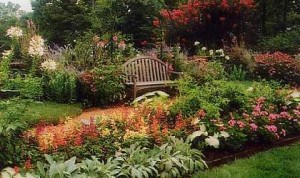Creating Focal Points in a Small Garden
Designing When Every Space Counts

Focal points are used in garden design to draw and direct the eye. Think of a garden, large or small, that was just a swath of plants. Your eye sweeps along, not knowing where to land. A sense of flow is nice, but without a focus, your garden is not really taken in and studied. It is quickly passed over. Now think of a garden you saw with a wonderful water feature, a weeping tree or a dramatic ornament. The first thing you notice is this focal feature. Once your interested is concentrated there, you start to branch out and notice other plants and features in the garden. The garden is slowly discovered rather than swept through. You don’t have to have a focal point, but your garden will appear more intentional if you do.

- An unusual specimen (Dwarf Magnolia, Anchor Topiary, or Dogwood)
- A large, architectural plant (Cimicifuga)
- A group of plants (a cluster of astilbe, bleeding heart, and ferns)
- A vibrant color (orange canna)
- A single white plant
- An ornament (Birdbath, gazing globe, statue…)
- Large boulders
- A dwarf shrub or tree
You don’t have to start your garden design with a focal point, but you don’t want to throw one in as an afterthought. Think about the style of garden you want and the plants you are considering using. Then list possible features that would complement yet stand out from your basic design. Some designs lend themselves to the obvious focal point: a Zen-like garden with a small water feature, a cottage garden with a cement statue, a formal garden with an obelisk.
If you have a preexisting large tree near your garden, that will become a focal point whether you mean to or not. You might want to enhance it with a birdhouse or a flowering vine, like climbing hydrangea.
Larger gardens often have more than one focal point, stopping the viewer as she surveys the whole scene. Small gardens generally only need one focal point, but it can make or break the garden. Don’t let that intimidate you. If you find you don’t like your first choice – welcome to the world of garden design. You can always try something else. One of the best ways to find out what you do like is to discover what you don’t.
Positioning Your Focal Point
Resist the temptation to center your focal point and plant around it. Use the 1/3 -2/3 rule and place the focal feature just off center. If you have a small, circular garden, place it towards the rear of your viewing perspective.
The closer you will be when viewing your garden, the smaller your focal point can be. In a garden next to a seating area, you don’t need drama to catch the viewer’s attention. A view from the dining room window some 60 feet away will be lost unless it dramatically stands out.
I’ve never found a magic formula for how large to make a focal point. A lot depends on where you are viewing from, plant choices and color. It often helps to use a stand-in for the focal point, a chair, ladder or your child.
Some Focal Point Tips
- Choose a proven performer. A sickly looking plant or one that perpetually gets eaten or mildew is not a good choice.
- Make sure it has a long peak period. Don’t fall for a short bloomer or a plant that only has one season of interest. no matter how spectacular it may be. Plants in small gardens need to pull their weight.
- It is possible to have seasonal focal points, in succession, but this requires planning and diligent maintenance. The idea behind a focal point is to attract the eye. If you spring focal point, say Bleeding heart, is going dormant or yellow before your next focal point, perhaps tall lilies, have come into their glory, the yellow foliage of the Bleeding Heart will be your current focal point.
Answer: Hi Jennifer, It can be confusing sometimes. A deciduous plant (tree or shrub) will go dormant (its rest period) beginning when either the weather starts becoming colder (40’s to ’50s) or when an area experiences a hard frost (temperatures dropping below 32 degrees, usually overnight). It will begin to lose its leaves at this time. Blooming plants have specific periods when they bloom. They aren’t always in bloom. Many will bloom either in spring or summer.
“Evergreen” is used to describe plants (trees/shrubs) that do not go dormant and retain their leaves or needles. This generally refers to pines, boxwoods, junipers, yews, and holly. Broadleaf evergreens are plants that retain leaves (very thick leaves) year round. But, they do shed the leaves periodically. This will apply to plants such as azaleas, spireas, and photinia. Until next time…Happy Gardening.
Jimmie
